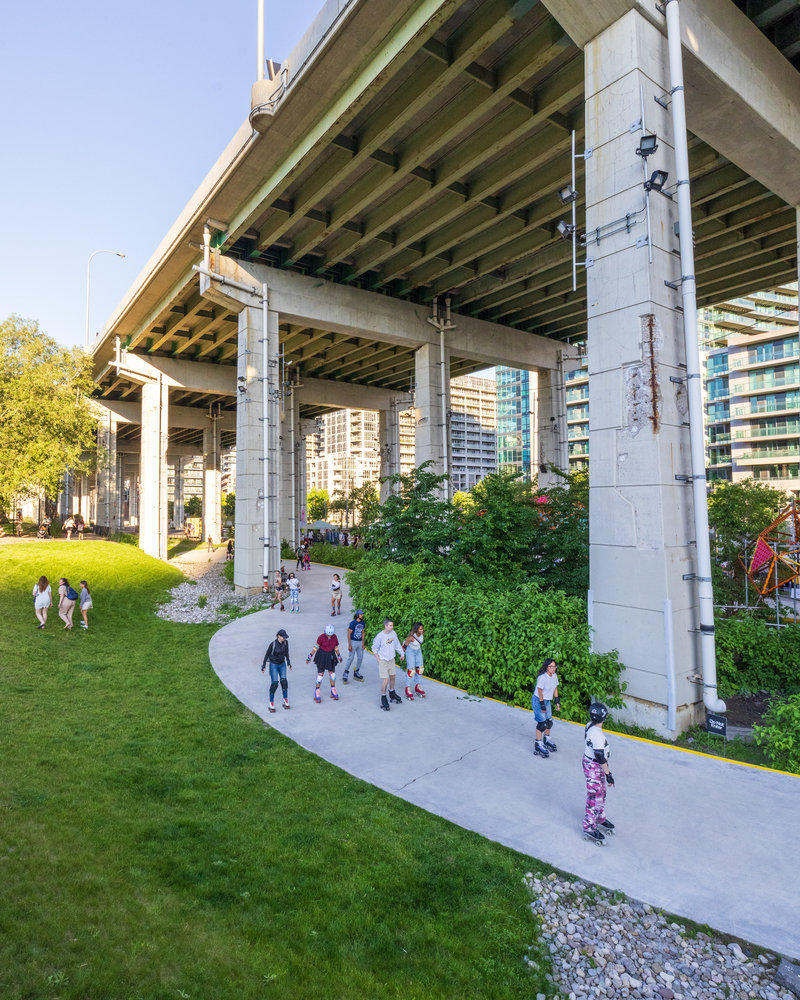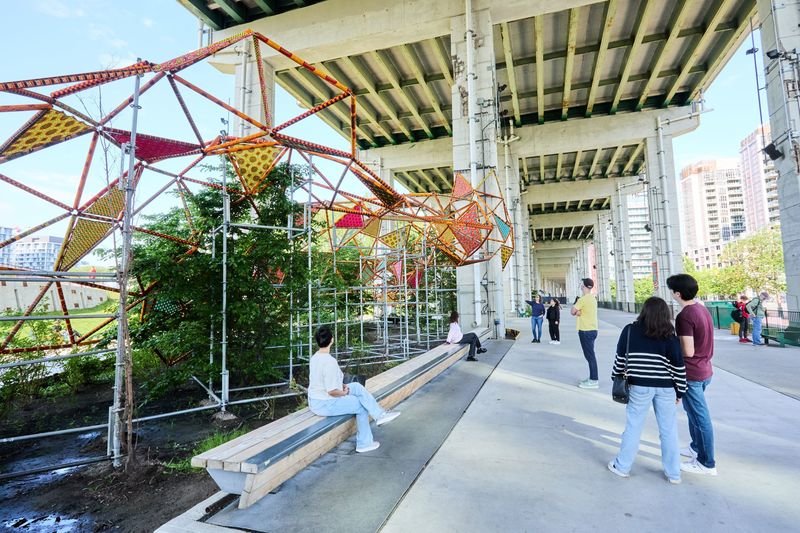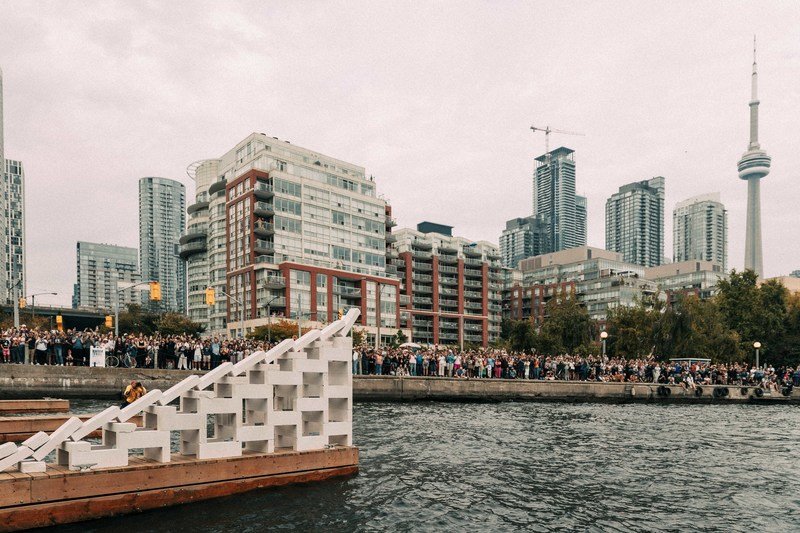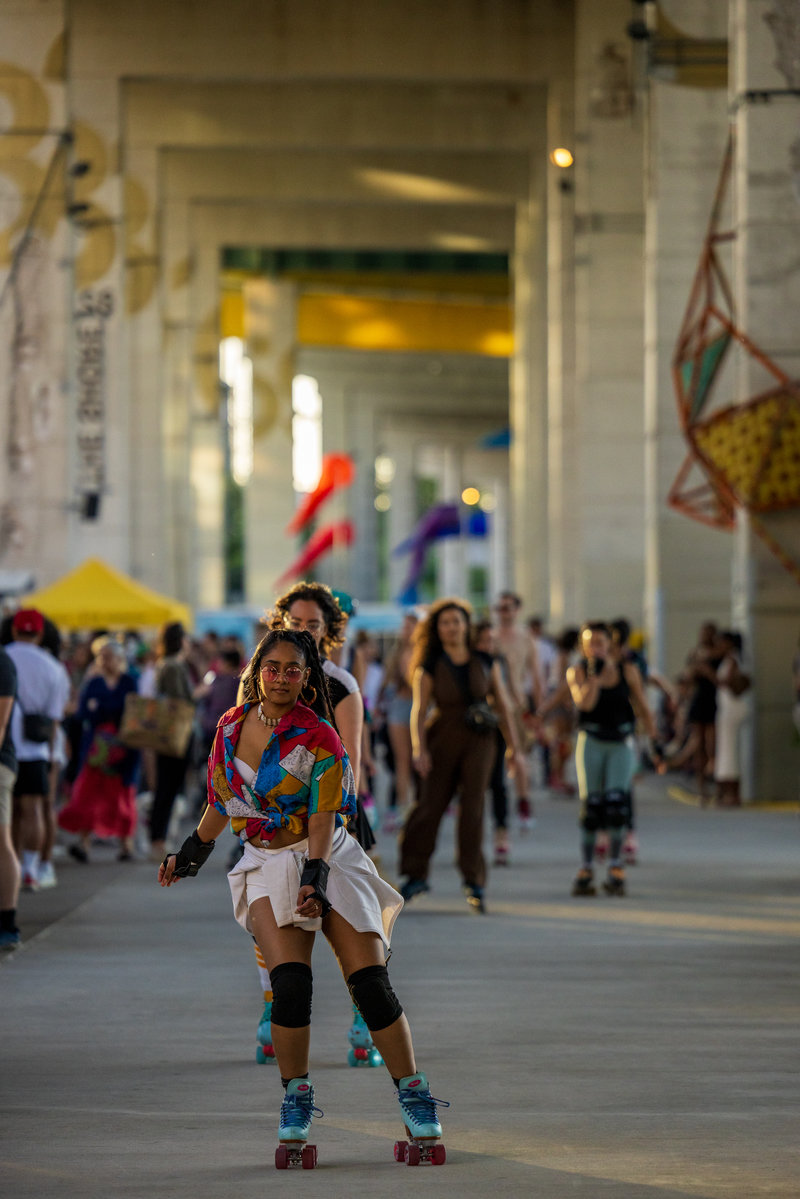Combatting the loneliness epidemic by reimagining public spaces: an interview with Ilana Altman, Co-Executive Director, The Bentway
Anchored under Toronto’s Gardiner Expressway — an elevated roadway running through dense downtown neighbourhoods — The Bentway way is a new type of public space and programming platform. The project supports the City of Toronto’s multi-year effort to revitalise the city’s waterfront and aims to be both case study and catalyst, informing the growing and connected public realm beneath the highway and the development of industrial reuse projects across the city.
As a significant creative driver in Toronto, The Bentway champions an artist-led movement to re-imagine the possibilities offered by the Expressway and explore pressing urban issues. The organisation’s mission is “to ignite the urban imagination”, using the city as site and subject. Each year, The Bentway adopts an overarching curatorial framework to guide the selection of creative partners.
Since May 2024, The Bentway’s focus has been on the epidemic of loneliness and the essential role public space plays in fostering and strengthening social bonds. This nonprofit organisation is aiming to better understand the interplay between public space, individual and neighbourhood health. Led by AEA Senior Associate Kathryn (Kit) Matthew, our interview with Ilana Altman Co-Executive Director, provides insights into The Bentway’s work, specifically how it is reimagining the Expressway, which had previously created physical divisions between neighbourhoods, as a new driver of community connection.
AEA: How did The Bentway identify community opportunities to improve mental health/wellness?
Altman: Each year, we invite local, national and international artists, designers and community programmers into work traditionally dominated by planners and policymakers. We believe these creatives are too often left out of important discussions, so we bring these varied disciplines together to explore and experiment. They collaboratively unpack urban issues to help demonstrate new approaches for the future development of our cities and public spaces. It always leads to amazing discoveries.
As we were developing our curatorial focus for 2024, we kept coming back to the growing crisis of loneliness that is prevalent in so many urban areas. The Toronto Foundation’s 2023 “Vital Signs” report (an annual report tracking the quality of life of city residents) named Toronto as the loneliest city in Canada. The statistics were staggering! 43% of adults never see their neighbours and 37% of Torontonians report feeling lonely at least three days a week. Unfortunately, it is not just numbers alone, you can feel the lack of social connection across the city.
We know that public spaces and public programming have an important role to play as we all look for ways to address this growing mental health issue. Public spaces have long modelled ways to make our cities more approachable, inviting, and conducive to forming social connections. We see it every day in our work at The Bentway. Now more than ever, we believe there is an opportunity to learn from our public spaces and discover new means of softening the barriers that separate us.
Our 2024 season, titled Softer City, brings together artists, designers, wellness experts and local residents to reimagine city-building based on new “soft” strategies. The projects explore new ways to humanise our cities and connect communities. Though the work is only in place through October 2024, the season has prompted us to look more closely at our long-term role within the broader neighbourhood.
We are asking ourselves: How can public art and shared spaces improve community cohesion and counter loneliness? How can we, as an organisation, inform conversations about planning and access for future public spaces? How can we use our programmes and spaces to promote social connection and help improve well-being?
Can you tell us more about how The Bentway is uniquely positioned to take on this kind of work, and why now?
The Gardiner Expressway runs for 7km through some of the densest and newest neighbourhoods in Toronto. We estimate that 120,000 people live within a 5-10 minute walk of our current site. That’s a small city!
The majority of these residents live in vertical communities with little access to public space. The neighbourhood is also very diverse: residents include young professionals, seniors and international students. Since a large part of the condo stock was designed as single occupancy dwellings, many people live alone, but increasingly young families are making their home here too. The space beneath the Gardiner has long been a place of significance for the unhoused and precariously housed communities and they continue to visit The Bentway. We serve as a backyard park and essential meeting ground for all these communities, who have many different needs and desires for public space. It is critical that we create the right conditions to foster social connection and offer social supports.
We are also Toronto’s first conservancy (a non-profit that is responsible for the stewardship of public space, including funding, operations and programming) and the first urban conservancy in Canada. Being designated as a conservancy means a commitment to working closely with the City and community partners to care for the space. This puts us in a unique position to work between public and private interests and raise awareness about pressing issues facing our community.
The growing phenomenon of loneliness is such a far-reaching issue. There are so many factors that contribute to loneliness and we aren’t so brazen to think that we can solve the problem alone, but we know that we have a critical role to play alongside city partners, social service providers, public health officials and other community leaders.
How did you find “unlikely partners” and what are their roles?
Our work is very much a part of a larger neighbourhood network — we are continuing to work closely with numerous community partners, with whom we have long-established relationships, including our local schools, business improvement and residents’ associations, the local public library and many others. Nobody can do it alone and we rely on the support and expertise of each of our partners.
Additionally, as each of our seasons have a unique focus, we think it is important to bring on seasonal partners with specific subject matter expertise to help inform our line of questioning and connect our work to ongoing research in the community. This year we are really fortunate to partner with the Dalla Lana School of Public Health at the University of Toronto, the Centre for Addiction and Mental Health (CAMH) and Gehl. They have helped us frame our approach and are continuing to help us to evaluate the impact of our work through health and public life studies throughout the season.
Can you tell us more about the 2024 Softer City season and what you were hoping to learn and share?
There were a number of questions we wanted to explore: How do we create space for artists to share their perspectives on loneliness, social connection and strategies for a softer city? How do we balance arts based-practice and arts-based experiences across the season? How do we incentivise participation and real engagement through our programmes?
We have been fortunate to work with amazing artists and designers who each responded to the seasonal prompt in different ways. Participating artists, Chloe Bass and Nico Williams encouraged us to question our current systems of care and create more opportunities for community-led recovery; WIP, Nnenna Okore and Rosana Cade developed projects that support new ways of sharing space and prompted new intimacy amongst neighbours; Heather Nicol created a new public sound sculpture that encourages interaction and reflects the community back to itself.
It has been amazing to watch the ways in which visitors have chosen to engage with the work —and each other— over the course of the season. That is my favourite part of what we do! The pieces have prompted people to spend more time on site, to strike up conversations with strangers and to find respite within a city that can feel alienating and overwhelming. Our hope is that visitors feel better, more inspired and more connected to one another as a result of their time at The Bentway and their engagement with these unique projects.
We have also hosted a wide range of arts-based workshops, social games, and recreational meet-ups over the summer. These highly participatory experiences are so important and so fun — and they are known to improve health outcomes. The research that University College London has been doing in this area has been particularly informative. Their arts and population studies have found that “frequent arts participation and cultural attendance were both associated with two outcomes. First better mental health as measured by lower mental distress. And second, higher well-being as measured by a sense of life satisfaction. They also found that arts engagement was associated with greater ability to cope with mental health problems in everyday life.”
Through our work with Dr. Kate Mulligan (a professor at the University of Toronto’s Dalla Lana School of Public Health and the Senior Director of the Canadian Institute for Social Prescribing) we are trying to better understand how we can support ongoing advocacy efforts to raise awareness about the benefits of social prescribing. It’s a growing movement in Canada that brings together the social and medical models of health and wellness, helping link clinical and social care by allowing health care providers to prescribe engagement with community-based programmes and spaces, such as attending dance classes, getting involved in a community gardening club, or volunteering. It’s such exciting work and we think it has enormous potential to change the way we conceive of, and value, public space and public programming.
It was shocking to see the ways in which civic engagement in Toronto has dropped in recent years. Volunteering has always been so important to me personally, and so beneficial. But people are not getting involved in the ways they used to, and it is leading to a lack of personal investment in our city, and a weakening of social networks.
Our marquee programme this season is designed to help renew volunteer networks in our neighbourhood. Dominoes is a touring project by Station House Opera in the UK. It is a larger-than-life, moving sculpture stretching across multiple downtown neighbourhoods and, over the course of a day-long event, unites neighbours in a common cause: setting up and setting off a chain of over 2.5 km of giant dominoes. Definitely one of our most ambitious projects yet!
The outpouring of interest has been amazing. We had over 300 people register to volunteer on the first day alone! The fall of the dominoes is going to be an incredible spectacle, but the real heart of the project lies with the hundreds of volunteers who work together to build the run. It’s a chance for people to meet their neighbours again and find joy in the act of collective building.
What role does staff hiring and training play in the success of mental health and wellness programming?
Our amazing staff members are the drivers behind this initiative and all that we do. They know our community best and are always asking what more we can do to engage the public in our planning efforts. It’s essential that the public knows The Bentway is a space for them, and that they feel welcome and represented.
Since we work with vulnerable populations, we also invest in trainings that help our staff strengthen their listening skills and de-escalation tools. We have developed trainings in-house that are particularly responsive to our space and community, including trainings that acknowledge the all-seasons nature of the work and that better prepare staff to engage with unhoused and precariously housed community members, by leading with empathy. More broadly, we want to empower staff to develop strong relationships with business owners, service providers, new arrivals, and longer-term residents.
Beyond good design, successful public spaces that are used and valued by the community are the product of successful relationships, so this work is ongoing. It requires frontline staff that are there to support community members and ensure the space and programmes remain responsive to their needs. I’ve been so encouraged to see the benefits of this work first-hand through the way our visitors respect and care for The Bentway. They have a sense of ownership and knowledge to share with other visitors. I think that is very much a reflection of the respect and care that they are shown by our staff. For example, as a result of our roller skate rentals and monthly community parties, many new community connections have been forged, resulting in regular meet-ups at The Bentway. People of all different skill levels and backgrounds see The Bentway as a place to learn and share. I love watching the impromptu lessons!
What is the internal governance and visibility of your mental wellness focus within your organisation?
We work in a highly collaborative way and all of our departments play a part in the development and delivery of our seasons.
The Softer City season, which is still underway, has been an opportunity to build new partnerships, learn from our community and see what aspects of our programming and operations are having the most significant impact on the neighbourhood’s health and wellbeing. At the conclusion of the season we collect our learnings in a publication that is shared broadly, and that we hope will be helpful to those working in public space.
Additionally, we also reflect on our learnings and make new organisational commitments. These commitments are then embedded in our annual strategic plan, departmental goals and individual staff KPIs. We have seen great success with this approach. Since the team has been involved in shaping the season and learning alongside the community, we are all really invested in the outcomes.
How is this work funded?
The Bentway is an independent charitable organisation that is fuelled by partnerships with the City of Toronto, residents, supporters, artists, and city-builders. Our funding comes from a variety of sources including philanthropy, government grants, sponsorship and earned revenue.
We are excited to see more funding becoming available to support non-profits working to address mental health issues in their communities. But given the scale of the problem and the importance of sustained efforts, more support is needed. It would be a huge step forward to have grants that prompt collaborative work between public health experts, clinicians and community organisations. This issue requires a sustained cross-sector strategy.
The partnerships we have built with healthcare providers and researchers through this season of programming is an important first step. But we are just at the beginning of our work together. This season is designed to help us set a baseline, to determine how our programmes and spaces are performing and to determine how we can improve our offerings to bolster health outcomes in the future.
How are you tracking impact?
Our traditional surveys have allowed us to track attendance and demographic information, but this season our partners have helped us to develop a series of new evaluation tools.
The University of Toronto’s School of Public Health researchers are running a facilitated survey to better understand the impact of our programmes and spaces on residents and visitor’s self-reported health and well-being. It includes questions such as: In which ways, if any, has The Bentway helped you feel healthier? Do your visits to The Bentway make you feel less lonely? Data collection is taking place across the season and will inform a community health evaluation, with a focus on social connection.
In parallel, Gehl is helping us conduct a public life survey — a methodology based on observations, interviews, measurements, photography and mapping to show how public spaces are used in practice. The data collected through the public life survey will provide a better understanding of the space’s performance and the story of people’s experiences. What features are encouraging people to stay at the Bentway? What programmes have prompted the most engagement?
Just working with our partners to prepare these surveys has been an eye opener. Together, these tools will help us set a baseline for our spaces and activities and allow us to track our impact year over year.
What advice would you have for other cultural organisations engaging in this work?
It is important to build a strong network of partners and create realistic goals about what you want to achieve year over year. Investing in data collection early on will help you to track your progress and see how the self-reported accounts of health and well-being change within your community over time.
These are multi-year efforts and change may be slow, but public space operators and public programmers can make a real difference. Don’t take for granted the importance of your work — it is the foundation for a strong and connected city.






